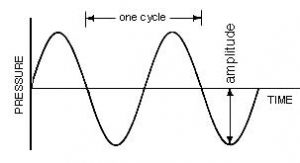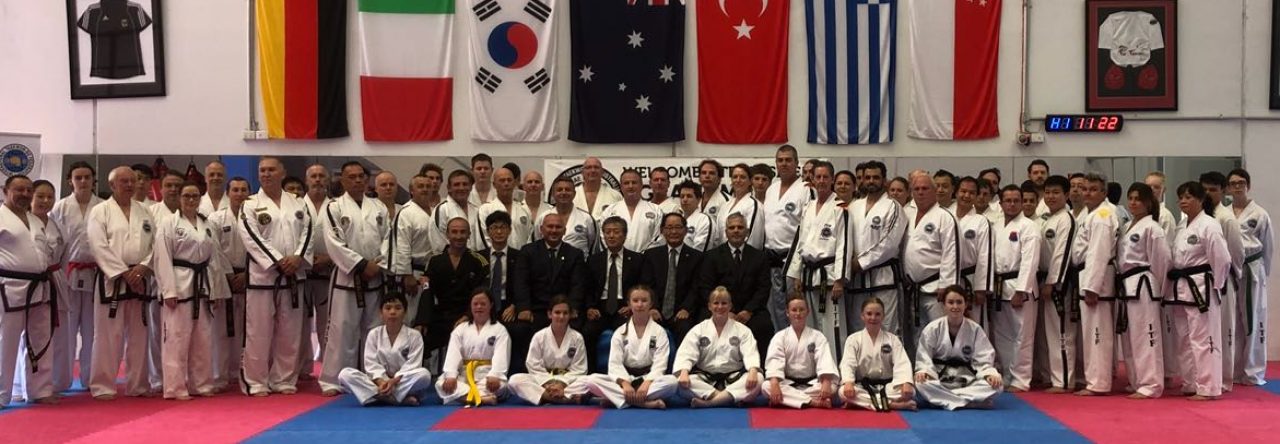The Ups and Downs of Sine Wave
To the uninformed and uninitiated all Taekwon-Do’s are the same, generally characterised by a few flashy kicks and a distinct lack of hand techniques.
Some who look a little closer will note a difference in Doboks, starkly different sparring rules and equipment, some difference in terminology, different versions of Taekwon-Do history and origins, different patterns (Chang Hon tuls or taeguk).
This is where the differences start to get interesting.
The performance of the patterns, and fundamental movements can vary quite markedly between Taekwon-Do factions, whether they be ITF, WTF, a breakaway version of either, or even independent styles purporting to be Taekwon-Do.
The WTF patterns and fundamental movements are characterised by vert short stances, with fast movement and incredibly high kicks. The path of the body is generally quite flat, along the lines of karate.
ITF is generally regarded for it’s patterns and fundamental movements, which are characterized by longer/deeper stances, also not unlike karate, with more emphasis on power on execution.
The argument over which are better is in the eye of the beholder.
One major difference between the ITF patterns (when performed correctly, of course), is the visually obvious appearance of a “up and down” dynamic referred to as Sine Wave.
In fact, so ingrained in this concept, that when asked the difference between their Taekwon-Do and that of others, many ITF practitioners will proudly boast “we have sine wave”, as if it were a badge of honour.
Yet how many practitioners really understand it, let alone perform and teach it properly ? All who perform it will argue that Sine Wave increases power of technique, yet some of the explanations of why and how are mind-boggling. Sometimes for the new student coming into Taekwon-Do, and especially for those coming into ITF from another form of Taekwon-Do can find it confusing and stressful.
In my travels and training over 20 years I have seen Sine Wave performed in so many variations, even within the ITF, and heard so many differing explanations as to why and how it is to be performed. I have even heard senior instructors call is Sand Wave, or Sound Wave, due to difficulties deciphering Taekwon-Do Founder General Choi Hong Hi’s Korean accent during his seminars. Try and ask an instructor for a clear and definitive answer of what sine wave actually is, and see how often you get the same answer twice.
I have my own funny stories about sine wave, although I confess to being less than amused at the time. I recall competing in a major NAS competition, a week after winning the Nationals Patterns Title, at a time when I was competing at World championships level in patterns (a week or 2 later). After performing my pattern well, and feeling good about myself, and leading the field of 30-odd until the last 3 competitors only to place 4th. I was told by the Head Judge that I would have won, “except for that annoying up and down motion you guys do”.
Ironically, those of us who have been around a while, all started Taekwon-Do when there was no Sine Wave. All the Masters originally learnt without Sine Wave, many still struggle with the concept today. Taekwon-Do forged it’s reputation as the most powerful martial art, with great feats of destruction, before the introduction of Sine Wave.
In this article, I will attempt to unlock some of the apparent mysteries of sine wave.
The most important thing to emphasize here is that Sine Wave does not create power.
Sine Wave contributes to creating powerful movement, in combination with all the other necessary components of force summation, breath control, timing, utilization of mass, acceleration of movement and so on.
It is a dangerous and ignorant fallacy shared by many ITF practitioners, to think that any movement without obvious sine wave cannot be powerful. There are many powerful techniques, performed by many martial artists that can produce incredible power, without ever having heard of sine wave.
Sine Wave – the name. Where the confusion begins.
The term sine wave is probably to first cause of the confusion and understanding.
Sine Wave refers to a mathematical graph often used when describing acoustics or simple harmonics.
A Sine Wave (or sinusoidal wave) is one that moves in a simple harmonic motion, where the oscillation is regular.
The diagram below demonstrates 2 cycles of a Sine Wave.

Confused yet ?
Ok, so now you can relate to the majority of ITF practitioners and prospective practitioners who don’t have the mathematics or physics background to cope with such a concept.
Common errors
Absence of Sine Wave
In the absence of Sine Wave, the body travels a very flat path, generally staying low, as in Karate, or very high, as per many WTF taekguk movements.
In both cases the body is still able to generate speed, create force, apply breath control, hip and shoulder torque and so forth, but does not take full advantage of the downward transferring of mass into the movement. All force is required to be produced horizontally.
When performing ITF patterns, they have a tendency to look faster, even rushed at times, as there is no need for the preparation time Sine Wave requires.
Having said that, my observation is that the majority of ITF competitors perform their movements too slowly, taking too long to complete a technique by over emphasizing this preparation time and exaggerating Sine Wave, reducing it’s effectiveness.
The Up/Down version
For the less scientifically minded, the Sine Wave concept is often simply referred to as ‘up and down’ motion.
The student often takes it too literally and the movement takes on a Mr Squiggle look about it. General Choi referred to this type of motion as a ‘saw-tooth’ motion, simply up and down.
This error is quite common and easily created when the practitioner raises the back heel, while either stepping or stationary (particularly in walking stance) without bending/dropping the back knee, causing the body to raise ‘upwards’.
It can also be caused by the stepping foot to be lifted too high, giving a ‘walking in mud’ appearance, or the foot not remaining flat, whilst stepping forwards. Anyone who had stuck their big toe in the mat whilst stepping knows this one.
It can also occur in Sitting Stance or L-Stance, whilst stationary, when the practitioner merely straightens their legs, causing the body to raise and then drops again.
It can be further made worse when this happens in conjunction with both heels raising off the floor.
The Sine Wave Squat
In an attempt to emphasize Sine Wave, and it’s initial downward motion/phase, many practitioners create a squatting-like action, with a very deep knee bend and significant body drop.
This creates a number of problems in itself:
- due to the time taken to travel the extra vertical height caused by the deep squat, the tools used for blocking or striking have to take an exaggerated preparation, slowing the execution time down quite markedly.
- Sometimes the hands even pause half way through in order for the rest of the body to catch up.
- The movement due to this exaggerated and prolonged preparation process, takes on an unrealistic look about it, and reduces it’s practicality in actual self-defence.
I’ve lost count of the many times I’ve been frustrated by watching Black Belts perform very prominent Sine Wave, yet execute very little power due to the absence of many of the other necessary components of Power, and still take out awards in Patterns competition, because often judges look for the visually obvious oscillations, rather than the purpose and ‘actual’ power of the movement. This misnomer has even crept into International competition, where competitors adopt strategies to mask lack of power, such as exaggerated stepping, or sharp head rotations and loud breaths.
So what is Sine Wave ?
Let me emphasize that Sine Wave should be a natural movement, not a forced or conscious action.
The focus should be on the technique you are about to execute and focussing all your power into the blocking or attacking tool.
During a ‘normal’ or regular stepping motion, Sine wave is generally created by the relaxation, or un-weighting, of the leg muscles at the initial stage of the technique’s execution, whether it be whilst stepping or whilst stationary.
It is this relaxation of these muscles which causes the body to drop slightly. This drop is subtle, rather than a distinctive ‘squat’. The body should be relaxed during this phase.
This is, in part, the backward motion referred to by the Training principal “every Motion commences with a backward motion”, in combination with the arms reaching their intermediate preparation position for the technique about to be executed.
The practitioner then increases their height, by extending their legs (but not fully locking them out) creating potential energy, before dropping again to the end of the technique, creating the appropriate stance.
It is this dropping which incorporates our body’s mass into the technique, utilizing the kinetic energy and gravity, to assist in adding to the power of the movement.
It is important that, whilst stationary, the heel remains flat on the ground and whilst traveling the foot remains flat and only slightly above the surface of the ground (a few millimeters, rather than centimeters).
Sine Wave and different types of motion
In addition to Sine wave whilst stationary, and Sine Wave whilst stepping in a regular fashion, we also have numerous speeds/types of motions which effect the type of sine wave executed.
Sine Wave in Slow motion
During Slow Motion movements, Sine wave is performed as usual, commencing with a slight downward motion, then upwards, and then downwards again. The movement is performed slowly in conjunction with slow breathing. An example where this is evident is the Palm Pressing Blocks in Joong-Gun tul.
Worth noting here are that there are no fast, powerful endings in a slow motion technique. Many practitioners still execute a sharp loud breath at the end of a slow movement (eg. Angle punch in Joong –Gun tul). The breath should be performed in proportion to the power/speed being executed.
Sine Wave in Fast motion
The Sine wave is still performed as per usual. The major difference between Fast and ‘normal’ movements, is the time interval the foot spends flat on the ground between movements is much shorter. You should still execute one sharp breath for each technique. An example of this concept is the two punches, as can be found in Do-San tul and Yul Gok tul.
Sine Wave in Continuous motion
In this case there is no pause between the end of one movement and the execution of the next. An example is the Outer Forearm Low Block and the Rising Block in Dan-Gun tul. You should still have one breath and create a separate Sine Wave for each technique.
Sine Wave in Connecting motion
In Connection motion, there is also no pause between two techniques, however in this case, there is only one breath and one Sine Wave for the two techniques, which is performed at the end of the second movement. An example of this Connecting Motion is the Palm Upward Block and Middle Punch in Ge-Baek tul.
Practical Application of Sine Wave
It is often an interesting exercise to watch a practitioner who swears by the Sine Wave as the be-all and end-all of ITF technique.
They will perform their patterns with a great emphasis on Sine Wave, and Step Sparring likewise.
However, when performing Self-Defence techniques, the Sine Wave often goes out the window.
There is no reason why Sine Wave can’t be executed during Self-Defence movements, however again, the over-exaggeration and the time taken to complete a technique often renders them impractical. Again, because often the full attention is on creating the Sine Wave, rather than the actual purpose of the technique.
Ask someone to throw the hardest punch they can and I will almost guarantee they do not execute sine wave, they will twist their hips and shoulders and throw the big haymaker.
In competition type sparring, Sine wave is virtually non-existent, as the objective in ITF sparring is not maximum power, rather maximum speed.
Summary
It cannot be stressed enough to allow the beginning student to move naturally first and get a feel for the movements rather than bombard them with Scientific and Mathematical concepts of Sine Wave.
People are often bewildered when I tell them that I don’t emphasize Sine Wave at all when I teach, given the success our school has had in ITF patterns at all levels. Yet, our students still execute Sine Wave and generate good power by focussing on relaxing between movements and making it as natural as possible.
Yet, I am a devotee of ITF technique and an opponent of Sine Wave, rather than a slave to Sine Wave at the expense of all other factors.
Sine Wave is certainly easier taught by demonstration rather than explanation, as students tend to mimic what they see performed, rather than what you tell them to do, at least until intermediate and advanced levels.
I’ve often stood there dumbfounded to observe an instructor try and rationalize and explain for ages Sine Wave to students as young as 6 or 7 years of age, to the point of overkill, turning the student who is just itching to kick, punch and block, off Taekwon-Do altogether
Remember, Sine Wave is not Power in itself, it merely contributes along with hip torque, breath control, reaction force, timing, acceleration, concentration, co-ordination and force summation.
 written by Master Michael Muleta, 8th Degree
written by Master Michael Muleta, 8th Degree
- President – United ITF Taekwon-Do Australia
- CEO – Global Fitness Institute

